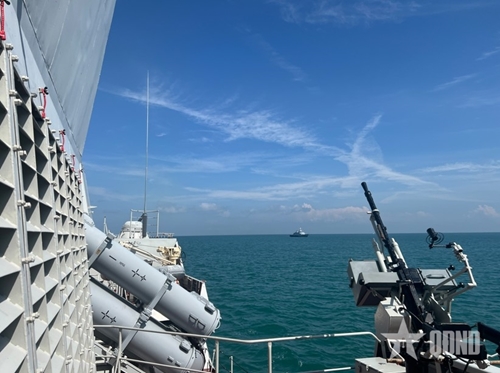The exercise stood as a testament to ASEAN navies’ determination to translate commitments into concrete actions for a peaceful, cooperative, and prosperous maritime region.
Following days of discussions ashore to unify exercise scenarios, participating ships conducted maneuvers including formation sailing, replenishment at sea, response to high-speed craft threats, aerial photo exercises, and saluting procedure at sea. The exercise, involving more than 1,200 personnel, also included three helicopters and one high-speed craft from the Royal Malaysian Navy (RMN).
    |
 |
|
ASEAN naval ships participating in AMNEX 3 |
Frigate 016-Quang Trung of Brigade 162, Vietnam’s Naval Region 4, demonstrated the professionalism of the Vietnam People’s Navy (VPN) through precise maneuvering and coordination within the formation. Under the leadership of Senior Captain Nguyen Vinh Nam, Deputy Commander of Naval Region 4, the VPN delegation actively and responsibly contributed to fostering cooperation, mutual understanding, and trust among participating navies for peace, stability, and development in the region and beyond.
Together with other recent ASEAN naval events, AMNEX 3 reaffirmed unity, confidence-building, and the collective commitment to maritime security cooperation. Yet, as Malaysian Minister of Defence Dato’ Seri Mohamed Khaled bin Nordin stressed during the 19th ASEAN Navy Chiefs’ Meeting (ANCM-19) in Penang on August 19, ASEAN continues to face formidable maritime security challenges. “We are all aware of ongoing gray zone tactics testing our resolve, such as foreign intrusions, maritime coercion, and covert infringements on sovereignty,” he said. He emphasized that ASEAN must remain the “anchor” of the regional maritime order, with the United Nations Convention on the Law of the Sea (UNCLOS) 1982 as the foundation of cooperation.
One of the exercise scenarios, countering high-speed craft attacks, reflected an attack method that is not new but has been on the rise recently with the support of new technologies. In addition, ASEAN navies also highlighted growing concerns over the protection of critical underwater infrastructure, including information cables, oil pipelines, and offshore energy facilities. This task is especially complex given their locations, multinational involvement, private stakeholders, and legal challenges.
Ensuring maritime security currently also hinges on leveraging technology effectively. Satellites, unmanned systems, and artificial intelligence offer advanced surveillance and response capabilities. ASEAN navies could integrate and share such technologies to fill critical security gaps. Yet, technology alone is insufficient, it must be applied strategically and coupled with close cooperation.
Admiral Datuk Zulhelmy Ithnain, Chief of the Royal Malaysian Navy, underscored, “The way forward is clear: technology is the catalyst, unity is strength, and people are the driving force.” By combining innovation with cooperation, ASEAN navies can build a sustainable, adaptive, and future-ready maritime security structure.
AMNEX 3 has contributed to reinforcing ASEAN naval cooperation. Concrete actions, coupled with firm commitments to a maritime region of peace, friendship, cooperation, and development, will help maintain ASEAN’s central role and readiness to address increasingly complex maritime security challenges.
Reported by Ngoc Hung
Translated by Trung Thanh